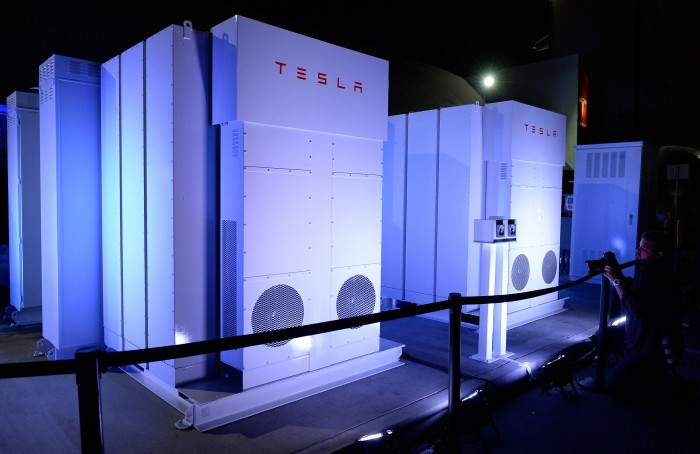Tesla Just Added a Huge Stack of Batteries to the California Power Grid
Tesla has just given California’s power grid a bit of backup.

When the California Public Utilities Commission was forced to close down the Aliso Canyon facility after its catastrophic methane leak, it realized it needed a means of meeting power demands at peak times. To that end, Tesla won a contract last September to build out 80 megawatt-hours of grid storage for Southern California Edison using its lithium-ion batteries.
Now the New York Times is reporting that it’s finished. And it's big. Tesla claims that it’s the largest lithium-ion battery storage project in the world, with 396 stacks of batteries able to provide enough electricity to power 2,500 households for a whole day.
The news certainly shows that Tesla can crank out batteries at an impressive rate. That will only increase, too, given that its huge Gigafactory battery manufacturing facility started mass production this month.
At first blush, it seems like good news. As the world transitions to power sources like wind and solar, we’re going to need lots of big batteries on the grid to smooth out their intermittent supply. Tesla’s installation in California is a demonstration of how that could work.
But there are some problems. First, lithium batteries remain expensive. It’s not clear how much this installation cost, but Bloomberg last year noted that Tesla will sell anyone a system a tenth the size of California’s for $2.9 million. Still, as electric cars hit the mainstream, large lithium batteries are expected to fall dramatically in price.
A bigger concern is with the hardware itself. Tesla doesn’t say how many cycles that the batteries in its Powerpack systems, which make up the installation, can tolerate before they degrade and reach the end of their useful life. But like other lithium-ion batteries, it’s likely in the thousands—probably around 5,000, the same as its Powerwall units. That’s not bad in a domestic setting, but could be quickly devoured in a grid setting.
Problem is, we’re not overrun with alternatives. The quest to build a great grid battery doesn’t sound too tough: it simply has to be cheap, made using common materials, and resilient to repeated charge-discharge cycles. The batteries don’t have to be portable, so factors such as size and weight aren't a design constraint.
Even so, such batteries remain elusive. Startups including Ambri, Eos Energy Storage, Aquion, and Sun Catalytix are all trying, but they’ve found that it’s far from straightforward. According to MIT’s Don Sadoway, the founder of Ambri, some of the money currently being funneled into lithium-ion battery development might be better spent on developing alternatives.
Tesla would be unlikely to agree. And for now at least, its batteries are probably the best solution there is.
(Read more: New York Times, Bloomberg, “What We’re Doing Wrong in the Search for Better Batteries,” “How Other Battery Manufacturers Could Help Tesla Reach Its Own Goals,” “Race for a New Grid Battery Hits a Speed Bump”)
Keep Reading
Most Popular
Large language models can do jaw-dropping things. But nobody knows exactly why.
And that's a problem. Figuring it out is one of the biggest scientific puzzles of our time and a crucial step towards controlling more powerful future models.
How scientists traced a mysterious covid case back to six toilets
When wastewater surveillance turns into a hunt for a single infected individual, the ethics get tricky.
The problem with plug-in hybrids? Their drivers.
Plug-in hybrids are often sold as a transition to EVs, but new data from Europe shows we’re still underestimating the emissions they produce.
Google DeepMind’s new generative model makes Super Mario–like games from scratch
Genie learns how to control games by watching hours and hours of video. It could help train next-gen robots too.
Stay connected
Get the latest updates from
MIT Technology Review
Discover special offers, top stories, upcoming events, and more.